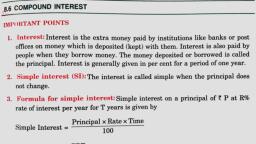Question 1 :
Find the roots of the quadratic equation (by using the quadratic formula): $-x^2+7x-10=0$
Question 2 :
Find the roots of the following quadratic equation by factorisation: $2x^2 – x + \frac{1}{8} = 0$
Question 3 :
John and Jivanti together have 45 marbles. Both of them lost 5 marbles each, and the product of the number of marbles they now have is 124. Write an equation to find out how many marbles they had to start with.
Question 4 :
Using method of completing the square , solve for x: $2x^2-5x+3=0$
Question 5 :
Check whether the following is quadratic equation : (x-3)(2x + 1)= x(x+5)
Question 6 :
What are the roots of the quadratic equation $2x^2-\sqrt{5}x-2=0$ using the quadratic formula.
Question 7 :
The difference of squares of two numbers is 180. The square of the smaller number is 8 times the larger number. Find the two numbers.
Question 8 :
Find two consecutive odd positive integers, sum of whose squares is 290.
Question 10 :
Find the roots of the following quadratic equation by factorisation: $x^2 – 3x – 10 = 0$
Question 11 :
A natural number whose square diminished by 84 is equal to thrice of 8 more than the given number is?
Question 12 :
Check whether the following is a quadratic equation: $(x + 2)^3 = 2x (x^2 – 1)$
Question 13 :
Find the roots of the quadratic equations, if they exist, by the method of completing the square: $2x^2 + x – 4 = 0$
Question 14 :
State True or False: Every quadratic equation has at most two roots.
Question 15 :
Justify why the following quadratic equation has two distinct real roots: $3x^2-4x+1=0$
Question 17 :
Check whether the following is a quadratic equation: $x(2x + 3) = x^2 + 1$
Question 18 :
Find the roots of the quadratic equations, if they exist, by the method of completing the square: $2x^2 + x + 4 = 0$
Question 19 :
Find the roots of the following quadratic equation (by the factorisation method): $\frac{2}{5}x^2-x-\frac{3}{5}=0$
Question 20 :
Represent the following situation in the form of quadratic equations : The area of a rectangular plot is $528 m^2$. The length of the plot (in metres) is one more than twice its breadth. We need to find the length and breadth of the plot.
Question 21 :
State True or False whether the following quadratic equation has two distinct real roots: $\left(x+4\right)^2-8x=0$
Question 22 :
The diagonal of a rectangular field is 60 metres more than the shorter side. If the longer side is 30 metres more than the shorter side, find the sides of the field.
Question 23 :
Find two numbers whose sum is 27 and product is 182.
Question 24 :
Check whether the following is a quadratic equation: $(x + 1)^2 = 2(x – 3)$
Question 25 :
Find the nature of the roots of the following quadratic equation: $3x^2 – 4\sqrt{3}x + 4 = 0$
Question 26 :
Using method of completing the square , $9x^2-15x+6=0$ can be written as ?
Question 27 :
Is it possible to design a rectangular park of perimeter 80 m and area $400 m^2$ ? If so, find its length and breadth.
Question 29 :
Using method of completing the square , $x^2+4x$ can be written as ?
Question 30 :
A cottage industry produces a certain number of pottery articles in a day. It was observed on a particular day that the cost of production of each article (in rupees) was 3 more than twice the number of articles produced on that day. If the total cost of production on that day was Rs. 90, find the number of articles produced.
Question 31 :
Which constant must be added and subtracted to solve the quadratic equation $9x^2+\frac{3}{4}x-\sqrt{2}=0$ by the method of completing the square?
Question 32 :
An express train takes 1 hour less than a passenger train to travel 132 km between Mysore and Bangalore (without taking into consideration the time they stop at intermediate stations). If the average speed of the express train is 11km/h more than that of the passenger train, find the average speed of the express train.
Question 33 :
State True or False whether the following quadratic equation has two distinct real roots: $\sqrt{2}x^2-\frac{3}{\sqrt{2}}x+\frac{1}{\sqrt{2}}=0$
Question 34 :
John and Jivanti together have 45 marbles. Both of them lost 5 marbles each, and the product of the number of marbles they now have is 124. Find out how many marbles they had to start with.
Question 35 :
Find the roots of the following quadratic equation (by the factorisation method): $21x^2-2x+\frac{1}{21}=0$
Question 36 :
Find the values of k for each of the following quadratic equations, so that they have two equal roots: $kx (x – 2) + 6 = 0$
Question 38 :
At present Asha’s age (in years) is 2 more than the square of her daughter Nisha’s age. When Nisha grows to her mother’s present age, Asha’s age would be one year less than 10 times the present age of Nisha. Find the present age of Asha.
Question 40 :
At present Asha’s age (in years) is 2 more than the square of her daughter Nisha’s age. When Nisha grows to her mother’s present age, Asha’s age would be one year less than 10 times the present age of Nisha. Find the present age of Nisha.
Question 41 :
At $t$ minutes past 2 pm, the time needed by the minutes hand of a clock to show 3 pm was found to be 3 minutes less than $\frac{t^2}{4}$ minutes. Find $t$.
Question 42 :
Check whether the following is quadratic equation : $x^3 - 4x^2 - x + 1 = (x-2)^3$
Question 44 :
Find the positive root of the equation $2x^2 + x - 300 = 0$, by factorisation.
Question 45 :
Represent the following situation in the form of a quadratic equation : A train travels a distance of 480 km at a uniform speed. If the speed had been 8 km/h lesss, then it would have taken 3 hours more to cover the same distance. We need to find the speed of the train.
Question 46 :
Find the roots of the quadratic equations, if they exist, by applying quadratic formula: $2x^2 + x + 4 = 0$
Question 48 :
State True or False: If in a quadratic equation, the coefficient of x is zero, then the quadratic equation has no real roots.
Question 49 :
Had Ajita scored 10 more marks in her mathematics test out of 30 marks, 9 times these marks would have been the square of her actual marks. The marks scored by her are?
Question 50 :
Check whether the following is quadratic equation : $(x+2)^3 = 2x (x^2 - 1)$














































